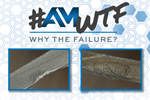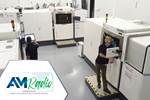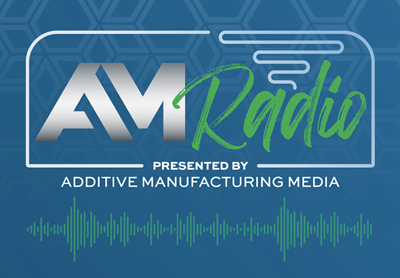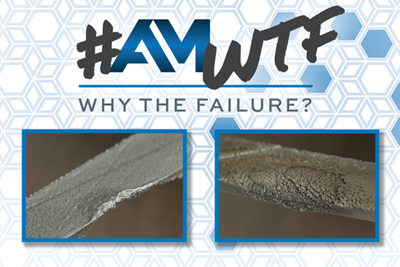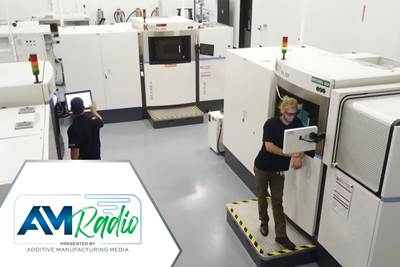5 Observations From Dr. Tim Simpson About the State of Additive Manufacturing So Far
The outgoing co-director of Penn State’s CIMP-3D takes stock of how far AM has come, aided in no small part through the work of the organization he helped to lead.
The maturity of additive manufacturing, or at least its maturing, can be seen in the fact there are organizations serving AM long enough to have become institutions. In one of these, a co-founder is passing an institutional legacy to a successor. Dr. Tim Simpson, co-director of the Center for Innovative Materials Processing through Direct Digital Deposition (CIMP-3D) at Pennsylvania State University since it was founded in 2012, is now stepping out of his director role to be replaced by Dr. Guha Manogharan.
It was not clear from the outset how far CIMP-3D would go. That is, how much influence it would prove to have and how large its footprint would come to be. Today, this AM technology and application group at Penn State has 20 full-time staff, about 50 affiliated faculty, about 50 graduate students involved in research, and a dozen systems for metal additive (the center’s specialty) covering practically every modality in metal AM. Three machines are from 3D Systems, which keeps an employee in residence at the site.
Simpson says, “We have been coupled with industry from the start.” Coupled with the U.S. Department of Defense as well. And this has been key — research projects arise from the gaps and needs brought by these organizations, often leading to direct real-world impact and the chance to expand into further work. Active projects for CIMP-3D right now include “easily dozens of DoD projects, about a dozen commercial industry projects and probably 15 or more NSF- or NIST-funded federal projects,” he says.
Simpson has been a friend and contributor to Additive Manufacturing Media for years — he has written articles and joined us in video and on our podcast. His transition offers a chance to look back on CIMP-3D’s progress, and through this, to see something about the advance and current state of AM. Here are a few observations:
1. AM has proven itself — that is not the challenge now.
“Early on, the questions we explored were always some version of ‘Does this work?’” he says. “There were a lot of tensile bar studies,” and 3D printing designs to prove they could be made. Few seek this now; additive’s capabilities are accepted. Instead, “many now are chasing certification and qualification,” because they recognize AM will address their production problems. He says, “3D printing is a design solution, but AM is a manufacturing solution.”
2. AM is still on an advancement and discovery path.
In the course of each project CIMP-3D undertakes, he says, “we discover new areas to explore no one knows yet.” The chance to pursue the next process or capability improvement generally leads to the next project with organizations committed to realizing and benefiting from additive’s promise. Most of the work the center does represents ongoing, next-stage advance in this way. “Eighty percent of our work comes from organizations we have worked with before,” he says.
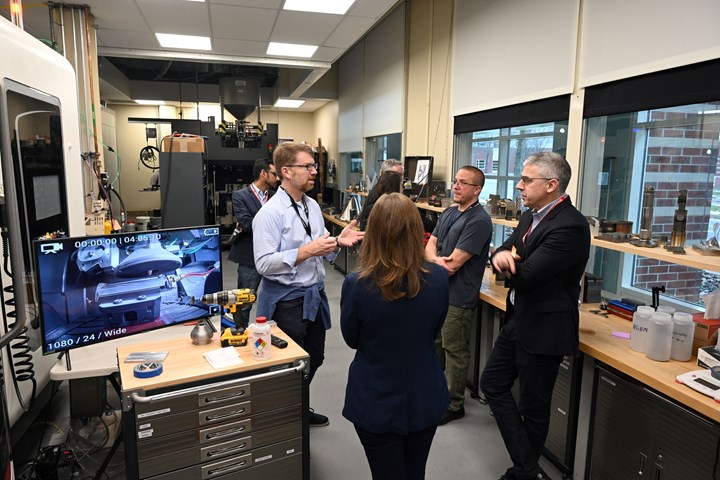
Taken during a visit to CIMP-3D just a couple of months ago. Tim Simpson is the one speaking. We are standing close to the facility's DMG MORI hybrid AM machining center. The research being performed on this machine involves 3D printing of aluminum for repair applications. The shroud around the deposition nozzle, seen on the video screen, provides for laminar flow of argon gas around the 3D printing. Tim is speaking to executive editor Stephanie Hendrixson (facing away from camera), CIMP-3D R&D engineer Cory Jamieson, and me. In the background directly behind Tim is Guha Manogharan, his successor as co-director. Source: Penn State.
3. Promising development areas involve other fields.
Additive is now well-enough established that commercial industry projects are often specific — say, focused solely on turbine manufacturing, for example. “We help them answer questions that are not broadly applicable,” Simpson says. The way he has found to go broader is to connect with researchers driving innovation in other industrial technology areas. Ultrasonic inspection is a recent example. “I get researchers like this pulled into the team,” he says, to explore how their technology and AM can aid and enable one another.
4. The business implications are being recognized.
“It is now my business school colleagues who are talking about additive,” he says. The supply chain benefits are becoming plain. The challenge is to understand choices about insourcing and outsourcing, including modeling for production lead time, and travel cost and distance, when additive is the mode. It’s not easy. “Current understanding of the economics of manufacturing does not map well to AM,” he says.
5. Learning from data is the wide-open frontier.
“The first digital manufacturing process appeared at the same time as artificial intelligence,” he says, and the implications of this have yet to be grasped. A large share of CIMP-3D’s work over time has involved gathering data; the three 3D Systems laser powder bed fusion machines have been modified to various degrees for sensor integration. However, “we are obtaining too much data to sort through.” AI is needed, he says.
Unfortunately, it is needed many places; capturing the interest of AI experts for manufacturing is difficult. Even so, the mindset of R&D around additive has to change. Simpson says, “We still think we need carefully planned experiments. We are still trying to devise experiments rather than learning from the data we have.” With AM, he says, “There is so much data — we ought to throw it into the AI mixer and see what we learn.”
Related Content
Lessons in Personalized Production From the 3D Systems Surgical Guide Process
Tailor-made manufacturing is one of AM’s richest possibilities, but the success factors inevitably draw on more than AM.
Read MoreHexagon Invests in Divergent’s Autonomous, Sustainable Manufacturing
The Divergent Adaptive Production System (DAPS) is a fully integrated software and hardware solution, creating a complete modular digital factory that combines AI-optimized generative design software, additive manufacturing and automated assembly to build lightweight automotive parts and frames.
Read MoreActivArmor Casts and Splints Are Shifting to Point-of-Care 3D Printing
ActivArmor offers individualized, 3D printed casts and splints for various diagnoses. The company is in the process of shifting to point-of-care printing and aims to promote positive healing outcomes and improved hygienics with customized support devices.
Read MoreNCDMM Enhances CORE Platform, Debuts Roadmapper 2.0 Data Tool
The CORE online platform helps members identify, access and utilize intellectual capital assets that align with the group’s Technology Development Roadmap, while Roadmapper 2.0 complements CORE, enabling the sharing of interactive, digital road maps.
Read MoreRead Next
Artificial Intelligence and Additive Manufacturing Are Connected: AM Radio #36
Stephanie Hendrixson and Peter Zelinski discuss how AI and AM go together. There are already plenty of uses of AI in 3D printing for design, process planning and process monitoring, and the link will grow stronger as the “frictionlessness” of AI blends with that of AM.
Read MoreMetal 3D Printed Part Should Be Flat, Has Bubble — AM: Why the Failure? #1
What should have been a straightforward application of laser powder bed fusion to make a simple component in 316L stainless steel turned into a printing fail. See why the failure happened.
Read MoreHow to Organize for Additive Production: AM Radio #42
Tim Simpson and Peter Zelinski discuss the next steps for succeeding with AM: After technical and process successes come the cultural, organizational and even costing considerations associated with this mode of manufacturing.
Read More


